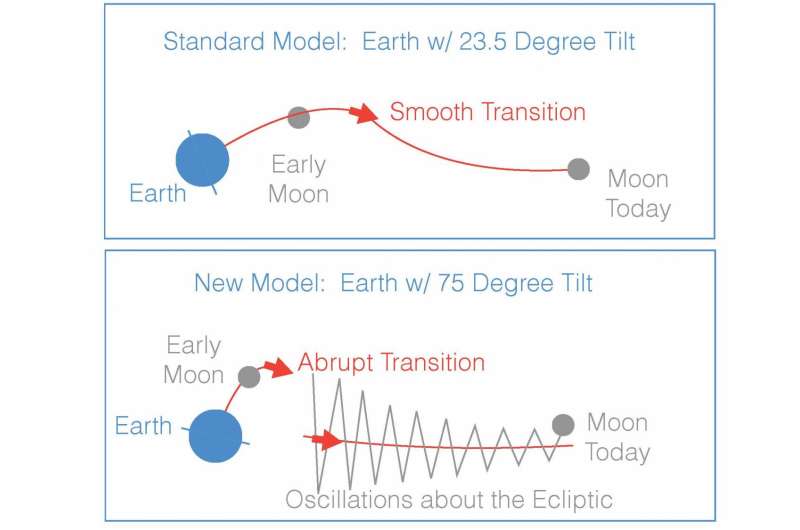New theory explains how the moon got there

Earth's Moon is an unusual object in our solar system, and now there's a new theory to explain how it got where it is, which puts some twists on the current "giant impact" theory. The work is published Oct. 31 in the journal Nature.
The Moon is relatively big compared to the planet it orbits, and it's made of almost the same stuff, minus some more volatile compounds that evaporated long ago. That makes it distinct from every other major object in the Solar System, said Sarah Stewart, professor of earth and planetary sciences at the University of California, Davis and senior author on the paper.
"Every other body in the solar system has different chemistry," she said.
The textbook theory of lunar formation goes like this. Late in the formation of the solar system came the "giant impact" phase, when hot planet-size objects collided with each other. A Mars-sized object grazed what would become Earth, throwing off a mass of material from which the Moon condensed. This impact set the angular momentum for the Earth-Moon system, and gave the early Earth a five-hour day. Over millennia, the Moon has receded from the Earth and the rotation has slowed to our current 24-hour day.
Scientists have figured this out by looking at the Moon's current orbit, working out how rapidly angular momentum of the Earth-Moon system has been transferred by the tidal forces between the two bodies, and working backwards.
But there are a couple of problems with the textbook theory. One is the Moon's surprisingly Earth-like composition. Another is that if the Moon condensed from a disk of material rotating around Earth's equator, it should be in orbit over the equator. But the Moon's current orbit is tilted off the equator, meaning some more energy must have been put in to move it.
An alternative to explain it all
Stewart, her former postdoctoral fellow Matija Ćuk (now a scientist at the SETI Institute in Mountain View, Calif.), with Douglas Hamilton at the University of Maryland and Simon Lock, Harvard University, have come up with an alternative model.

In 2012, Ćuk and Stewart proposed that some of the angular momentum of the Earth-Moon system could have been transferred to the Earth-Sun system. That allows for a more energetic collision at the beginning of the process.
In the new model, a high energy collision left a mass of vaporized and molten material from which the Earth and Moon formed. The Earth was set spinning with a two-hour day, its axis pointing towards the Sun.
Because the collision could have been more energetic than in the current theory, the material from Earth and the impactor would have mixed together, and both Earth and Moon condensed from the same material and therefore have a similar composition.
As angular momentum was dissipated through tidal forces, the Moon receded from the Earth until it reached a point called the "LaPlace plane transition," where the forces from the Earth on the Moon became less important than gravitational forces from the Sun. This caused some of the angular momentum of the Earth-Moon system to transfer to the Earth-Sun system.
This made no major difference to the Earth's orbit around the Sun, but it did flip Earth upright. At this point, the models built by the team show the Moon orbiting Earth at a high angle, or inclination, to the equator.
Over a few tens of million years, the Moon continued to slowly move away from Earth until it reached a second transition point, the Cassini transition, at which point the inclination of the Moon—the angle between the Moon's orbit and the Earth's orbit about the sun—dropped to about five degrees, putting the Moon more or less in its current orbit.
The new theory elegantly explains the Moon's orbit and composition based on a single, giant impact at the beginning, Stewart said. No extra intervening steps are required to nudge things along.
"One giant impact sets off the sequence of events," she said.
More information: Matija Ćuk et al, Tidal evolution of the Moon from a high-obliquity, high-angular-momentum Earth, Nature (2016). DOI: 10.1038/nature19846
Journal information: Nature
Provided by UC Davis


















